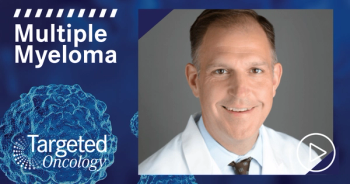
Published Findings Uphold Carfilzomib OS Benefit in Myeloma
Overall survival was extended for patients with relapsed or refractory multiple myeloma by nearly 8 months with the combination of carfilzomib, lenalidomide, and dexamethasone compared with lenalidomide and dexamethasone alone in results from the phase III ASPIRE trial.
Keith Stewart, MB, ChB
Overall survival (OS) was extended for patients with relapsed or refractory multiple myeloma by nearly 8 months with the combination of carfilzomib (Kyprolis), lenalidomide (Revlimid), and dexamethasone (KRd) compared with lenalidomide and dexamethasone alone (Rd) in results from the phase III ASPIRE trial, published in theJournal of Clinical Oncology.
As reported at the 2017 ASH Annual Meeting in December, the findings showed that the median OS was 48.3 months for patients assigned to KRd compared with 40.4 months for those assigned to Rd (HR, 0.79; 95% CI, 0.67-0.95;P= .0045). KRd was associated with an 11.4-month survival advantage in patients at first relapse (47.3 vs 35.9 months; HR, 0.81, 95% CI, 0.62-1.06).
“Results from the final analysis of the phase III ASPIRE trial…are significant, as they further validate carfilzomib, lenalidomide, and dexamethasone as a standard of care regimen for patients with relapsed or refractory multiple myeloma,” principal investigator Keith Stewart, MB, ChB, Mayo Clinic-Arizona, said in a press release. “Furthermore, these data showed that early use of carfilzomib, lenalidomide, and dexamethasone at first relapse provided nearly 1 additional year of survival for patients, regardless of prior treatment with bortezomib (Velcade) or transplant.”
ASPIRE enrolled 792 patients who had received a median of 2 prior treatment regimens. Patients were randomly assigned to the 3-drug carfilzomib regimen (n = 396) or lenalidomide plus low-dose dexamethasone alone (n = 396). In both groups of the trial, 66% of patients had received prior bortezomib and 20% had prior lenalidomide.
In both arms, lenalidomide was administered at 25 mg on days 1 to 21 and dexamethasone was administered at 40 mg on days 1, 8, 15, and 22 of a 28-day cycle. Intravenous carfilzomib was administered on days 1, 2, 8, 9, 15, and 16 during cycles 1 to 12. On day 1 and 2 of the first cycle, carfilzomib was administered at 20 mg/m2 followed by 27 mg/m2 thereafter. Treatment with carfilzomib was not administered on days 8 and 9 during cycles 13 to 18 and was not administered beyond 18 cycles.
The OS benefit with KRd versus Rd was consistent across patient subgroups, including those stratified by age (<75 years: HR, 0.80; ≥75 years; HR, 0.80), ECOG PS (0 or 1: HR, 0.79; 2: HR, 0.69), and nonresponsiveness to bortezomib (HR, 0.73).
Among patients who had received 1 prior line of therapy, KRd was associated with a 12-month improvement in median OS in patients with prior bortezomib exposure (45.9 vs 33.9 months; HR, 0.82; 95% CI, 0.56-1.19) and by 7.9 months in bortezomib-naïve patients (48.3 vs 40.4 months; HR, 0.80; 95% CI, 0.55-1.17).
KRd improved median OS by 18.6 months among patients with prior transplantation at first relapse (57.2 vs 38.6 months; HR, 0.71; 95% CI, 0.48-1.05). The addition of carfilzomib also extended OS by 6.5 months in patients who had received ≥2 prior lines of therapy (48.8 vs 42.3 months; HR, 0.79; 95% CI, 0.62-0.99).
At a median follow-up of 48.8 months for the carfilzomib arm and 48 months for the control arm, the median progression-free survival was 26.1 months versus 16.6 months, respectively (HR, 0.66; 95% CI, 0.55-0.78;P<.001). Findings from the initial interim analysis showed an overall response rate of 87.1% versus 66.7%, with KRd versus Rd, respectively.
The safety analyses included 392 patients in the KRd group and 389 in the Rd group who received at lease 1 dose of study treatment. Median treatment duration of carfilzomib in the KRd group was 72 weeks and the median relative dose-intensity of carfilzomib was 93.7%.
Overall, 85.9% of KRd patients and 90.4% of Rd patients discontinued treatment. The most common causes for discontinuation in both groups were disease progression and adverse events (AEs).
Roughly 98% of both groups experienced any-grade treatment-emergent (TEAEs). The most common AEs (≥10%) that occurred more often in the KRd group were cough (29.6% vs 18.0%) and hypokalemia (29.6% vs 14.9%).
In the KRd group, 87.0% of patients experienced grade ≥3 TEAEs compared with 83.3% in the Rd group. The rate of serious AEs was 65.3% for KRd and 56.8% for Rd. Patients assigned to KRd were more likely to experience grade ≥3 acute renal failure (3.8% vs 3.3%), cardiac failure (4.3% vs 2.1%), ischemic heart disease (3.8% vs 2.3%), hypertension (6.4% vs 2.3%), and hematopoietic thrombocytopenia (20.2% vs 14.9%). Rates of peripheral neuropathy were similar between groups.
In July 2015, the FDA approved the KRd regimen for the treatment of patients with relapsed multiple myeloma who have received at least 1 to 3 prior lines of therapy, based on PFS data from the ASPIRE trial. The FDA approved carfilzomib in January 2016 for use in combination with dexamethasone or with lenalidomide plus dexamethasone for patients with relapsed/refractory multiple myeloma following prior treatment with 1 to 3 lines of therapy, based on findings from the phase III ENDEAVOR trial. The agency subsequently approved a supplemental new drug application in January 2018 that added OS data from the ENDEAVOR trial to the label for carfilzomib.
Reference:
Siegel DS, Dimopoulos MA, Ludwig H, et al. Improvement in overall survival with carfilzomib, lenalidomide, and dexamethasone in patients with relapsed or refractory multiple myeloma [published online January 18, 2018].J Clin Oncoldoi: 10.1200/JCO.2017.76.5032.










































